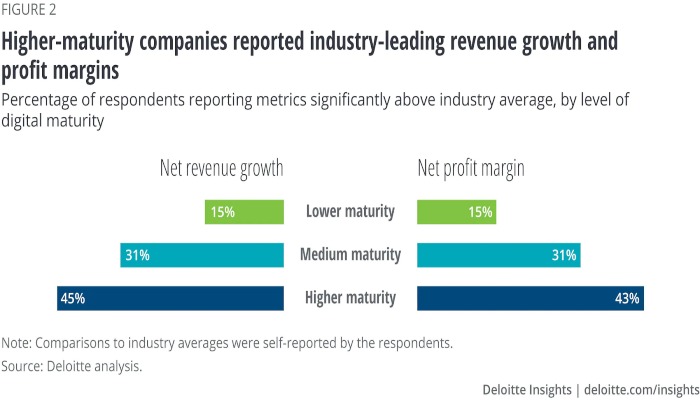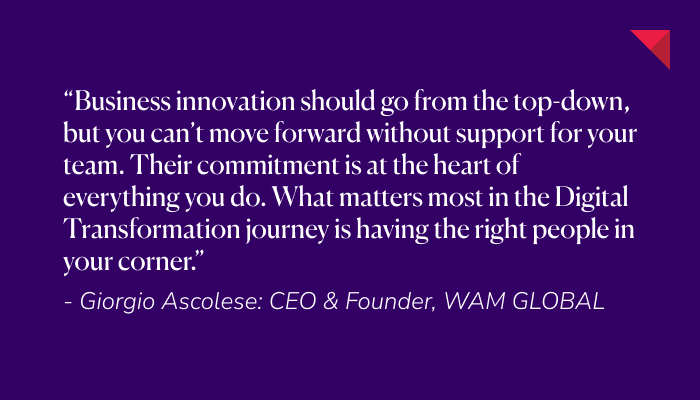Should CEOs Take Charge of Business Innovation?
Technology is no longer merely a tool for business owners and CEOs to use as they please. Business innovation has become a critical point for any enterprise to articulate from managing the marketing experience to product development.
Companies from various industries need to transform their business processes to embrace available technology and successfully overcome all the challenges they face.
Business model innovation: the key to success
Digitization and business innovation within organizations are growing movements that have seen an expected boost due to the impact of the COVID-19 pandemic. A Forbes survey found that 80% of businesspeople accelerated their digital transformation initiatives because of the pandemic.
The Digital Economy in Spain report from Adigital cited two influential primary factors in this phenomenon:
- Circumstantial factors such as the rise in digital demand, such as a 50% growth rate in e-commerce.
- Structural elements like accelerating digital programs or a rise in working from home (WFH), according to data from Spain’s National Statistics Institute (INE), moved from 5% to 34% in a single month.
Today, there are very few people who dispute digitization’s importance in an organization. Those firms that were already working on implementing the Digital Transformation managed to stabilize, pivot, and start to recover before their peers.
Some even decided to boost their tech spending due to the pandemic, with 29% of Salesforce’s customers stating they did so, according to research in The State of Salesforce 2020 - 2021 report. They’re also predicting that those organizations’ chances of their businesses rebounding is 47% higher.
A trend that's here to stay in 2021
We’ve spent months immersed in a “new normal” that’s here to stay in some way, shape, or form. During the most recent Black Friday shopping campaign in Spain, Google research found that brick-and-mortar retail sales decreased 12.7% while e-commerce sales grew by 23%. In the US, Google research from the summer found that 75% of US consumers planned to shop online more than they did during previous holiday shopping seasons, along with more people saying they would search for gift ideas online rather than in-store. We’ve acquired new behaviours and habits, even at the office.
Enterprise technology is now a critical component for operating their business. Still, the trends for 2021 tell us that those solutions that allow organizations to be more flexible and increase their ability to adapt to change will be the most important.
Gartner’s Top Strategic Technology Trends for 2021 cited the following trends:
-
Omnichannel, connected experiences: The Customer Experience is what concerns marketers most when crafting marketing strategies. The increased prominence of diverse, mobile, virtual interactions makes enabling hybrid experiences even more crucial. A 360° marketing approach that offers a cohesive, consistent brand experience is fundamental.
-
Improved privacy: Technology that protects users and safeguards their privacy is gaining prominence. The Gartner report predicts that half of all organizations will put solutions that address these concerns by 2025.
-
Operations from anywhere: Businesses can offer in-person and virtual experiences for employees and customers alike. Employees will get support from anywhere while customers can access company resources in their desired channel. This shift goes beyond mere working from home as it considers secure, remote access, an enhanced digital experience, and more.
-
Artificial Intelligence: Organizations must deploy robust engineering structured in AI. The three core pillars are DataOps, ModelOps, and DevOps. This approach is the only way to achieve performance, scalability, reliability, and of course, a favourable ROI. We must also consider it since the report found that only 53% of AI initiatives make it out of the prototype stage.
-
Hyperautomation: Hyperautomation refers to how companies look to automate as many business processes as possible. This practice is fundamental at this current juncture of digital transformation and is key to organizations’ resilience and operational excellence. Gartner Research VP for Technology Innovation Brian Burke declared: “Hyperautomation is irreversible and inevitable. Everything that can and should be automated will be automated.”
The result oh having innovation in business processes
Digital Transformation drives business performance. According to a Deloitte report, those organizations with more digital maturity have better financial performance. They are three times more likely to see an increase in the annual net earnings and a boost in their profit margins.
 The CEO's role in innovation inside an organization
The CEO's role in innovation inside an organization
Even if a CEO understands the importance of their company's technology agenda, to what extent should they be involved in the Digital Transformation? Should they take charge and lead the movement, or should they take a step back and focus their attention elsewhere?
Today, I'm going to answer these questions and show you why CEOs should be key figures in business innovation and technology in their organizations.

Create a tech vision that your employees can believe in
Digital transformation is only useful when people across the firm are committed to implementing new tools and collaborating on solutions to drive results.
The CEO's responsibility is to create and communicate this vision to the rest of the company to rally everyone behind a common goal of business innovation.
All employees should have a clear understanding of the company's tech agenda, how it relates to them, and how it can drive personal and professional success. This idea is especially true for high-level executives and fellow board members. Any digital transformation is doomed if it is not believed in and enacted from the top down.
Therefore, be crystal clear about your tech plan's strategic benefits and how it directly relates to business growth and long-term profitability.
Lead by example and be a positive role model
With the previous point in mind, the CEO is also in the perfect position to be a positive role model for the rest of the company by effecting digital change personally. Stay up to date on disruptive technologies that show potential in your industry and visibly use any new tools getting rolled out in your organization.
It's also important to highlight any technological victories and success stories for the rest of the company. If a new tool or process has increased lead generation by 15%, tell your employees about it, and give credit where credit is due.
While CEOs don't have to become experts on niche technological products, they should have a broad understanding of how specific technological advances can impact their business and the overall industry. Armed with this knowledge, CEOs can drive positive change in their organization and leverage technology to achieve key business objectives.
People: The drive for success
If innovation is critical for an enterprise's success, people are even more fundamental. There's no single technology solution that can digitize an organization if its members don't want to deploy it in their day-to-day functions. Their commitment and the management team's determination are crucial for any initiative in this area to progress. We can therefore say that an organization's human capital is its primary engine of change.

In this unprecedented year, professionals have demonstrated an extraordinary ability to adapt and commit while working from home, using new tools, and adapting their processes to provide the same service and more while operating remotely.
We’ve had to change our behaviours, adapt our corporate culture to physical distancing, and sometimes rethink things to move forward. All of this is impossible without a committed team. What matters most in the Digital Transformation journey is having the right people in your corner.
Subscribe to our newsletter and stay up to date with the latest digital trends.
Subscribe to our newsletter and stay up to date with the latest digital trends.
No thanks. My inbox is fine as it is.